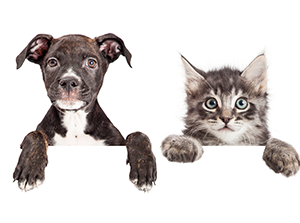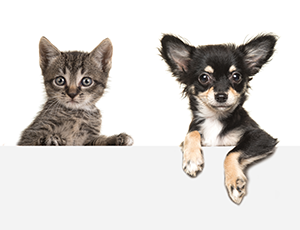Heatstroke and Your Pet

As Spring warms up into Summer and the humidity and heat start to really set in, it's good to remember that, like every other member in your family, you need to take extra care with your pet. You can become dehydrated and dangerously hot, which can result in falling unconscious at best, vital organ damage, or at its very worst, death. The same is true for your pets!
We tend to think of animals as hardier than humans, but the truth is, dogs and cats begin to experience heatstroke (hyperthermia, medically speaking) at the same internal body temperature as humans do — 104° F. Severe heatstroke begins at 105° to 106° F internally, as well. It might be more difficult for you to gauge temperature with smaller pets such as hamsters, but there's one rule of thumb to keep in mind. Always watch the heat index. Meteorologist uses the heat index value to discuss what the temperature is once humidity is applied; it's this balance of heat and humidity that are dangerous to the health of your pet and you.
If the heat index is 90° F, you need to be sure to take precautions to protect your pets. They won't be able to ask you to turn on the air conditioning or ask you for extra water, or even to tell you they're starting to feel ill. Your pets depend on you to responsibly monitor the weather and give them what they need to stay healthy and comfortable.

Prevent heatstroke before there are any problems
Animal's bodies work differently than human bodies. For instance, cats and dogs only sweat through the pads on their feet while rabbits dissipate heat through their ears. What keeps you cool may not help your pets to stay cool, and if you're ever unsure about how to care for your specific pet, please feel free to ask us!
Here are some basic tips to help you help your pet avoid heatstroke:
Use an air conditioner. Because of the way your animals sweat, a fan by itself will not be enough to help them release body heat.
Be prepared for severe or disastrous weather that could disable power in your home. This may increase the risk of heat stroke, as you will have a harder time providing cool water.
Consider using the basement when you're leaving your pet alone at home. Since it's underground, it will be naturally cooler.
Provide plenty of shade and ventilation. This is true while you're indoors, but it's especially important when you're outdoors. When outdoors, ensure nothing could keep your pet from reaching the shade (e.g., leash getting stuck on something).
Keep your pets indoors both on very hot days and during the hottest part of the day, and avoid ground that will retain heat, such as asphalt and sand.
NEVER leave your pet in the car unattended, no matter how quick your errand or how shady your parking spot is. Cracking the windows is not enough to ensure the safety of your pet. It is pets being left in vehicles that is a leading cause of hyperthermia-related pet deaths.
Do not muzzle larger pets, like dogs. Panting is part of their cooling process, and how they pant will help you determine how well or poorly they're reacting to the temperature.
Make sure your pet has easy access to water, and if you're going to be out of the house, consider using a pet fountain that will prevent spillage. Putting ice cubes in your pet's water will also help them keep their internal temperature down. Note: Older or impaired animals may drink less water than other pets; be sure you make cool water even easier to access.
Use ice packs or similar DIY options (e.g., frozen water bottles) to help your pet cool itself. For small pets, you can put this in their cage for them to lay against. Larger animals may need them wrapped in a towel so they can lay on top of them.
Apply water to keep your pets cool. This could be something small, such as misting your rabbit's ears, or something wetter, like letting your dog have a dip in the pool.
Give your pets cool treats, like peanut-butter Popsicles or chilled wet food.
Take extra care with animals that have certain high-risk factors, including heart or lung disease, obesity, or thick-hair coats.
Symptoms
Early stages of overheating can be treated at home, but you should check in with your veterinarian to make sure your pet isn't suffering from any internal or more serious effects. Hopefully, you can catch these symptoms quickly and prevent heatstroke from progressing, but once the condition of your pet has moved to heatstroke, you will need to take immediate action and bring your pet to your veterinarian as quickly as possible.
Symptoms of overheating include:
Unusually rapid panting with the tongue hanging out.
Lethargy.
Unwillingness to move.
Dehydration.
Rapid or irregular heartbeat.
Difficulty urinating.
Black or tar-like stool.
Vomiting and diarrhea.
Uncoordinated movements and muscle weakness.
Dizziness or stupor.
Glazed eyes.
Thick saliva.
Dark red or very pale discoloration of moist tissues (gums and tongue)
Vomiting blood.
Bloody stool.
Sudden breathing distress, possibly with fluid in the lungs.
Muscle tremors and seizures.
Shock.
Coma.
Even lizards and birds can experience heatstroke. Stiffness, discolored skin or tongue, rigidity, lethargy, and loss of appetite are a few signs that these pets may be experiencing heatstroke. Be sure to talk to us about your specific pet so you will know what to watch out for.
Effects
Even if your pet seems better once you have normalized their body temperature, they may still be injured. Always bring your pets into your veterinarian for assessment and treatment in order to prevent more serious internal problems.
These internal issues may include:
Acute kidney failure.
Cardiac or pulmonary distress or arrest.
Blood clot dysfunction or disorder.
Systemic inflammatory response system.
Liver disease, disorder, or cell breakdown.
Depression or other mental changes.
Hydrocephalus (abnormal accumulation of fluid around the brain).
If left untreated, heatstroke can result in death.
Treatment - What you can do
If you determine that your pet does have heatstroke, you will need to handle your pet with extreme care. For example, making them too cold, or making them cold too quickly, can cause problems such as an increased risk of shock or hypothermia. The latter will cause the blood vessels to constrict, making blood flow difficult and prevent your pet from actually being able to cool down.
In the case of small pets, you will want to wet their paws and ears with cool water. Wetting the fur will also help as it will imitate the process of sweating. It is especially important to cool small pets down slowly, otherwise, there's an increased risk of life-threatening complications. Once you've brought their temperature down some, wrap them in a wet towel gently and loosely to keep them cool while you transport them to a local emergency veterinary hospital.
Caring for larger pets is similar. You will want to bring your pet's body temperature down to a safe level (about 103° F) by wetting their fur with cool water or by using cloths wet with cool water placed in key locations such as the back of the head and the armpits. Allow them to drink water or lick ice if they are thirsty, but do not give them cold water or try to force them to drink. You can use a children's re-hydration drink or add a little salt to their water to help restore minerals lost from overheating. Once they are at a normal temperature, dry your pet thoroughly to prevent hypothermia and bring them to an emergency veterinarian immediately.
If you've found your pet unconscious and are unable to wake them, bathe them in cool water, being careful not to let water get into their nose or mouth, as this can result in aspirated pneumonia. Bring them to an emergency veterinary hospital as quickly as possible, and if you can, put a cold pack against their belly during transport. Frozen water bottles or bags of frozen vegetables can double for an ice pack.
Treatment - What we can do and Aftercare
Once you've brought your pet to us, we offer an array of services to meet the specific needs of your pet.
These include:
Temperature regulation.
Respiratory aid.
Blood tests.
Clot tests.
Full body exam.
Tests for damage to internal organs.
Treatments based on our diagnosis.
In most cases, pets can fully recover complication free. However, your pet may temporarily or permanently require a special diet if there are complications. Always remember that pets who have experienced heatstroke once have a greater risk of experiencing it again.
If your pet's behavior has not returned to normal after a few days (or as otherwise discussed with your vet), bring your pet back for further assessment.





